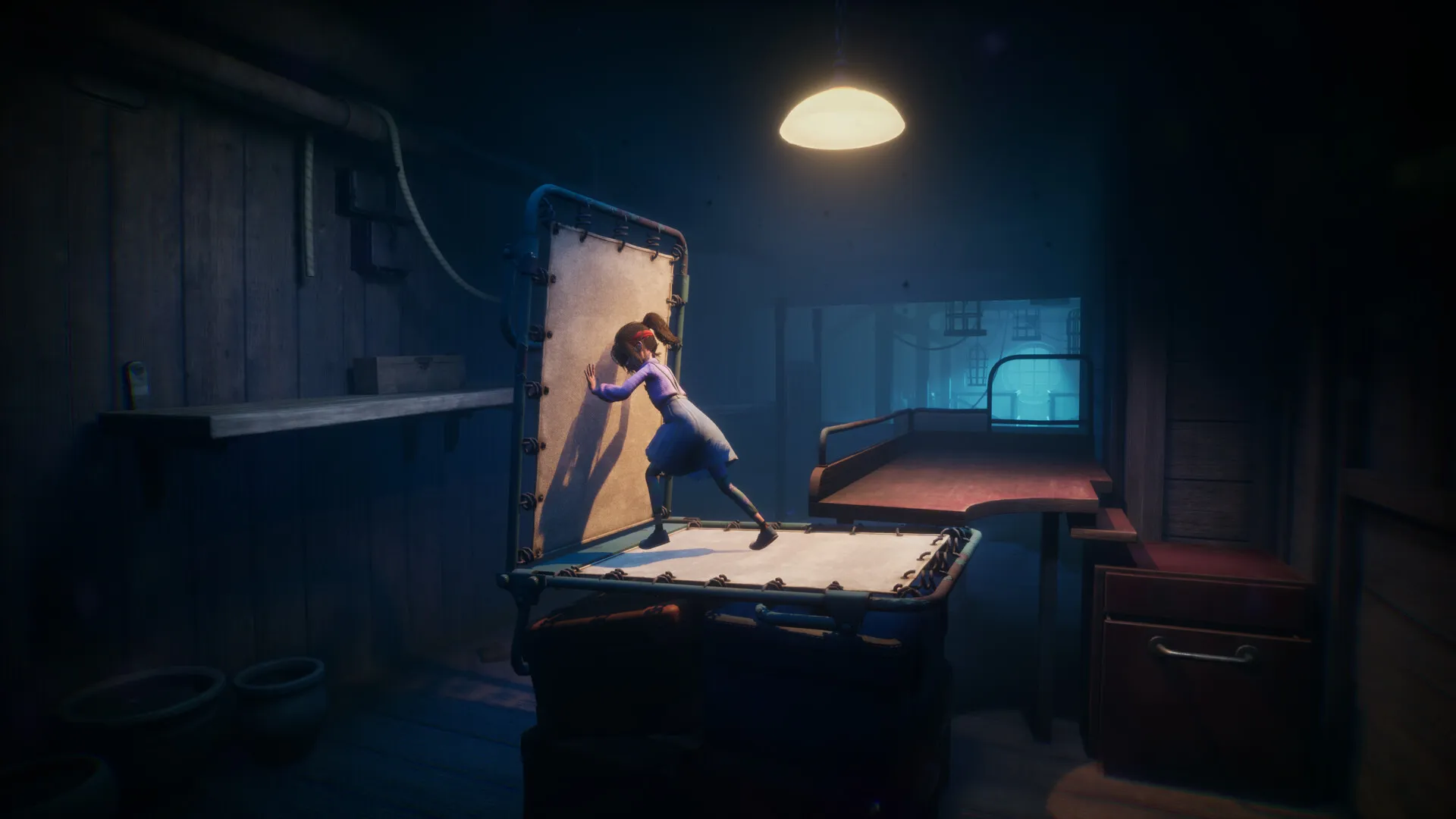Imagine creeping through a moonlit hallway where every floorboard groan echoes in your ears. That’s Sophie’s reality in Out of Sight, a horror puzzle game that casts you as a blind girl trapped by cultists in a decrepit mansion. Through an occult bond, she borrows vision via her teddy bear’s eyes, shifting your perspective from Sophie’s bodycam-like view to Teddy’s fixed vantage point.
In roughly three hours, you’ll guide her past shadowy cages and down dusty corridors, racing both time and unseen predators. This setup plants the seed of tension from the first moment you place Teddy on a pink blanket—little do you know how often you’ll return to that ritual.
Gameplay & Mechanics
The core trick occurs when Sophie sets Teddy down and the camera snaps to his stitched button eyes. You aim Sophie with the left stick, then swivel Teddy’s view with the right. Switching at will, you survey levers, keys and pathways from two angles. That shift rewrites each room’s meaning: a blocked corridor from Sophie’s view may reveal its solution from Teddy’s perch.
Rooms present classic block-pushing, lever-pulling and key-finding tasks. Early puzzles are gentle teases—a chair drags into place, a lever pulls a gate open—while later chambers layer in multi-step setups. A standout moment asks you to use Teddy’s sight to trigger a distant switch, then race back to Sophie’s spot. Still, the challenges rarely demand more than logical pattern recognition, leaving some of Teddy’s potential untapped.
Before long, cultist elders roam the halls. They patrol in slow arcs, alerted by misplaced Teddy or shuffled furniture. Stealth here isn’t punishing: Sophie crouches beneath tables and edge-walks behind curtains until the threat passes. Its real thrill arrives in chase segments, where the camera sometimes flips—Teddy becomes hunted instead of guide—forcing a frantic scramble that contrasts sharply with the usual tempo.
Sophie moves at a deliberate pace that heightens dread yet can feel sluggish during backtracking. Grabbing Teddy, pushing objects and vaulting onto surfaces share buttons, which leads to occasional misreads—Sophie might shove a box when you meant to lift your friend. Those hiccups jar the mood, but most of the time the controls support the tense rhythm of exploration.
Story, Themes & Emotional Impact
Out of Sight unfolds like a dark fairy tale: Sophie awakens in chains, discovers her sight through Teddy, then races room to room toward freedom. Each new area raises the stakes, from creaking nurseries to shadow-haunted galleries, building a simple arc of escape and revelation.
Scattered shoes at wall-bound restraints, cages for child-sized bodies, eyeless portraits in every hallway tell a grim backstory without words. These bits of worldcraft deepen the mystery of Sophie’s captors and hint at past victims. A single teddy bear in a dusty crate reads as a silent warning.
Sophie murmurs to Teddy, seeking comfort in grainy whispers. Yet their bond plays out in one direction—she talks, he serves as camera—leaving space to question how that link affects her psyche. Does Teddy truly comfort, or is he just a tool for survival?
Why can Sophie see only through her toy? What ritual awaits her if capture returns? These unanswered threads hover at the edges, lending a haunting “what if” that lingers after the credits.
A late-game chase in a pitch-black corridor, with Teddy’s view fighting for light, ranks as the most visceral jolt. When capture seems inevitable, Sophie’s screams echo through your headphones, sending a primal chill down the spine.
Atmosphere, Presentation & Technical Performance
Out of Sight dresses its horror in storybook hues: pastel playrooms drip candlelight onto dusty floors, while shadowy corners swallow every vibrant toy. The art feels more like a stop-motion fable than a gore-soaked thriller, giving contrast to the dread beneath each cheerful surface.
Silence reigns until a floorboard creaks. Soft lullabies taunt from distant rooms, and your headset pulses with footsteps and Sophie’s muffled sobs. That audio tension fuels fear more than any jump scare, tapping into our instinctive protectiveness toward a child in danger.
A few quirks sidetrack progress: Sophie can snag on geometry, forcing a checkpoint rewind, and one reviewer even lost a save file without warning. Checkpoints are frequent, though, so most bugs cost only minutes. Still, they break immersion when they strike.
On mid-range PCs, you can max out detail settings without dipping below 120 fps. The experience clocks in under three hours. Collectibles and achievements pepper the mansion, but chasing them adds little depth—most players finish once and move on.
The perspective-shifting idea shines bright, yet feels lightly explored across its short span. It delivers bursts of creativity amid a framework of familiar puzzles and stealth. For fans of narrative-driven horror who welcome fresh twists, it’s a brief but memorable escape. For players craving longer or tougher challenges, this visit may feel too fleeting.
The Review
Out of Sight
Out of Sight brings a fresh perspective mechanic and haunting mood, even if its three-hour length and occasional glitches prevent it from fully realizing its vision. Its puzzles and stealth segments generate genuine tension, and the game’s visual and audio design evoke a chilling fairytale come to life.
PROS
- Innovative perspective swap between Sophie and Teddy
- Rich audio cues that amplify suspense
- Storybook-like visuals against grim settings
- Tense stealth and chase moments
- Stable frame rates on mid-range hardware
CONS
- Runtime clocks in under three hours
- Puzzles often lack depth
- Control overlap can cause unintended actions
- Occasional clipping and save-file glitches
- Little incentive to replay beyond achievements

















































